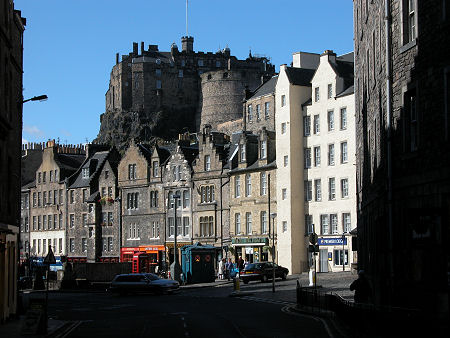 Edinburgh's Grassmarket, Where Nasmyth Was Born |
Alexander Nasmyth (or Naismyth) lived from 9 September 1758 to 10 April 1840. He was a landscape and portrait painter who has often been called "father of Scottish landscape painting". The wider picture in Scotland at the time is set out in our Historical Timeline.
Alexander was born in Edinburgh's Grassmarket, the son of a wealthy builder. He was educated at the Royal High School in Edinburgh and the Trustees’ Academy before becoming an apprentice heraldic painter to a coachbuilder. In 1774, while still only sixteen, his talent was spotted by the artist Allen Ramsay, who offered Alexander work in his London studio. While there Alexander became accomplished enough to be trusted with finishing work on Ramsay's own paintings.
Nasmyth returned to Edinburgh in 1778 and rapidly found himself in demand as a portrait painter. He also helped Patrick Miller of Dalswinton by producing technical drawings for Miller's paddle-driven steam boat, and did a family portrait for Miller. In return Miller loaned Alexander enough money to go to Italy, where he travelled around the country studying Italian art from 1782 to 1784.
On his return to Edinburgh, Nasmyth switched his output to landscapes of Scotland, produced in a very Italian style. His work was encouraged by the poet Robert Burns (who's portrait he also painted), and the two would often walk together through scenic areas of central and southern Scotland.
Over time. Nasmyth's style of landscape painting evolved from its Italian beginnings under the influence of Dutch landscapes, and as a result of the work of contemporaries. He also established a landscape school at his home at 47 York Place in Edinburgh. As a teacher he was highly innovative in insisting his pupils draw from real scenes in the open air, rather than simply reproduce existing drawings or paintings. Nasmyth also developed a sideline in architecture, being responsible for the Dean Bridge in Edinburgh and the temple-like structure atop St Bernard's Well in Stockbridge.
When Alexander Nasmyth died in Edinburgh in 1840, he left a significant legacy in the form of his portraits and landscapes, and in the careers of those he had taught. These included his eldest son, Patrick Nasmyth, who went on to establish himself as a successful landscape painter; his daughters, Anne, Barbara, Charlotte, and Jane, all of whom also became painters; and his youngest son James Nasmyth, who became famous as the engineer and inventor responsible for the successful development of the steam hammer before, in retirement, also turning to art.
